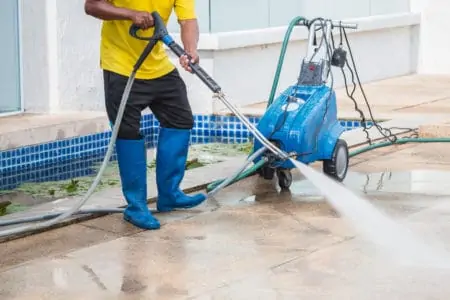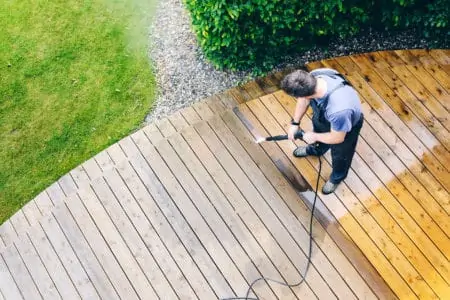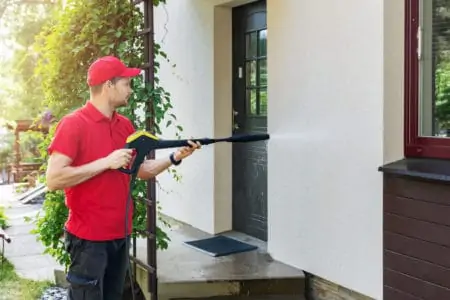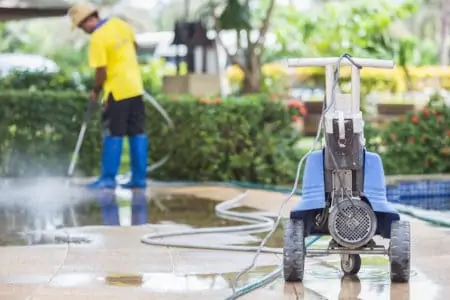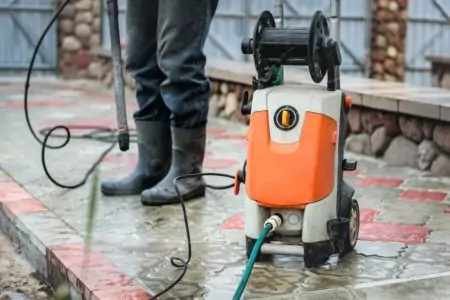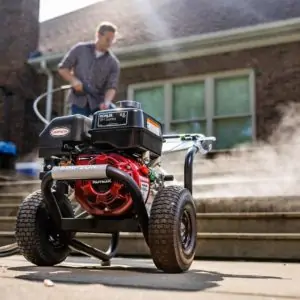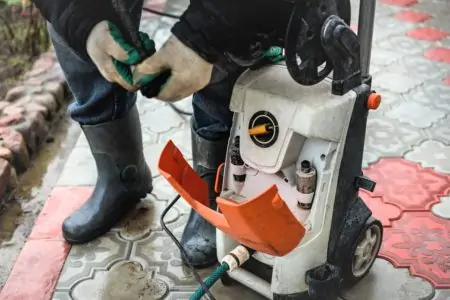It can be a stressful time when the winter months start to creep in. Longer nights, the pressure of end-of-year deadlines, and not least of all, the risk of your appliances freezing. One thing that many people might forget about is their pressure washer.
You shouldn’t head into the winter months without properly prepping your pressure washer. You can’t just shove it in the tool shed until spring-time. Nope. You need to know how to winterize a pressure washer to prevent it from freezing, cracking, rusting and other damage.
We’ll show you how, whether you have a gas or electric pressure washer.
Key Takeaways
- Winterize pressure washers to prevent freezing, cracking, and rusting.
- For gas pressure washers, use fuel stabilizer, clean water, and antifreeze pump saver.
- Electric pressure washers require hot water and antifreeze pump saver for winterization.
- Store pressure washers in a warm, dry spot and cover for protection during winter months.
Why You Should Winterize Your Pressure Washer
In the colder months, your pressure washer is at risk of dry rot and cracking. The gasoline can also go stale, whereas the ethanol in the fuel can lead to rusting, corrosion and clogging.
None of that sounds very good, does it? So it’s important to winterize your pressure washer.
Winterizing your pressure washer protects it from cold temperatures. It also maintains the internal seals and protects the gas-powered units (if you have a gas pressure washer).
If you store the pressure washer somewhere that isn’t insulated, then the next time you go to use it — even if it’s only a few weeks later — you may find your pressure washer is leaking, broken or damaged in other ways. This can cost you hundreds of dollars, since it’s now beyond repair.
How to Winterize a Gas Pressure Washer
Both gas and electric pressure washers should be winterized differently. Let’s start with the gas pressure washers, as these take a bit more time.
What You Need
- Fuel stabilizer.
- Garden hose.
- Bucket with clean water.
- Antifreeze pump saver.
- Clean cloth.
Step by Step Instructions
- Add the fuel stabilizer to the tank and run the engine for two minutes so that it can circulate it through the system.
- Now it’s time to empty the pressure washer. Hook it up to your garden hose as normal.
- Fill up a bucket with clean water and put the pressure washer detergent feed tube in there.
- Attach a low pressure nozzle and turn the pressure washer on. Pull the trigger to empty the water from the tank. This may take a few minutes.
- Turn off the hose and remove it from the pump, disconnecting all other hoses. Drain all water from hoses, the pressure washer gun and any extensions.
- You will now add your antifreeze pump saver which you should do so according to the manufacturer’s instructions.
- Wipe down the pressure washer with a damp cloth.
- Cover it and store it.
Top Tip
How to Winterize an Electric Pressure Washer
If you own an electric pressure washer, you should also take steps to winterize it. This will be a bit easier.
What You Need
- A bucket of clean water.
- Garden hose.
- Antifreeze pump saver.
- Cloth.
Step by Step Instructions
- Fill a bucket with hot water — at least a gallon large.
- Place the detergent suction hose into the bucket of clean water or fill the onboard tanks with hot water.
- Attach your garden hose to your pressure washer and turn it on.
- Hold the gun and spray water for two minutes to clear the system of all detergent residue.
- Disconnect the garden hose and pull the trigger again to get rid of any leftover water from the system.
- Remove the high pressure hose and disconnect both the trigger gun and wand to let them drain.
- Add antifreeze pump saver to the pump inlet to protect the inner seals, as per the manufacturer’s instructions.
- Use a cloth to wipe down the pressure washer and cover it.
- Store it indoors in a warm space to prevent freezing and internal seal damage.
Extra Tip
How Do You Winterize a Pressure Washer Without Antifreeze?
Check the manufacturer’s instructions. However, it’s very unlikely that the manufacturer would recommend winterizing your pressure washer without antifreeze. It’s a crucial step.
Tips for Storing Your Pressure Washer in Winter
Before you go, here are some top tips for storing it in the winter.
- If possible, store it in a warm dry spot. If you have a basement or garage that gets some heat, that is a better choice over a cold shed.
- Make sure to cover it for extra protection in case anything falls or bumps it. This also protects it from dust, water and debris.
- If you can’t store the pressure washer somewhere heated, at least remove the parts, hoses and other components to store those inside. This will protect the hoses and seals from cracking or damage.
- If you have an outside tap, use a tap jacket to protect it from freezing.
FAQs
Winter Is Coming
Are you ready? The cold months are already pretty miserable. Don’t make it worse by neglecting the job of winterizing your pressure washer and finding it damaged a few months later.
It’s not a hard job. If you follow our tips correctly, depending on whether you have a gas or electric pressure washer, you’ll be good to go.
Make sure you have a good antifreeze product. Without it, you run the risk of freezing, even if you’ve definitely emptied the tank.
